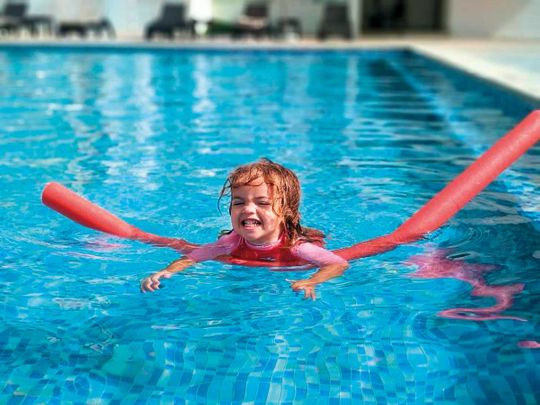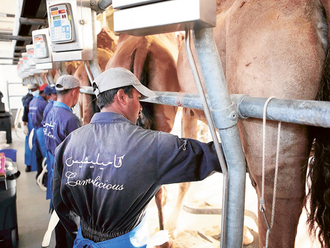
DUBAI: The accidental drowning of twin boys aged two-and-a-half in a neighbour’s residential swimming pool in Ras Al Khaimah on June 6 brought back into focus the issue of child safety in and around swimming pools as well as the issue of how soon should children be taught the skill of swimming.
In its latest water safety guidelines, the American Association of Paediatrics (AAP) has recommended that children start swimming lessons around age of one to help decrease the risks of drowning. This is the first time the AAP has suggested children begin learning water safety skills at such a young age.
“Research has found that swim lessons are beneficial for children starting around age one,” Linda Quan, a co-author of the policy statement, said.
According to Jess Hammond, of Hamilton Acquatics, which provides coaching in swimming in Dubai and Abu Dhabi, “Children from the age of three months can enrol for swimming lessons. Programmed sessions that use structured play mean that children and babies from a young age will learn to enjoy the water instead of fearing it.
At this age, says Hammond, it is all about gaining water confidence, so even splashing around and trickling water over their faces during bath time will help to make them comfortable in the water.
“Parent and child classes with children from three months to three years old also help with bonding and educate the parents on how to handle children in the water without fear,” says Hammond, who was voted Swim England Tutor of the year and so far has been responsible for the training or qualifying of over 100 teachers last year.
Reflex actions
“There is a common misconception of parents who believe their babies will swallow too much water [if they are in the pool at a very early age] but the extrusion reflex in babies will stop this from happening,” she adds.
However, swimming lessons are not a one-size-fits all for children. “Not every swim class will suit every child,” says Hammond. “Our teachers keep in mind that every child learns at a different rate, meaning there will be different activities and progressions within one lesson to meet the child’s needs. Lessons that are grouped by ability, rather than age, create the most streamlined, enjoyable and effective sessions.”
According to AAP, not all swimming pools are equal. They must be checked for size, depth, indoor, outdoor, and staff and facilities. Says Hammond. “As long as the swimming teacher is fully qualified, they will be able to teach a safe and enjoyable lesson no matter the location. It is, however, essential that the teacher or lifeguard at the pool carries out the necessary pool checks to make sure the water is safe to swim in. This includes testing the water temperature and chemicals, such as chlorine – if the tests are outside of the safe parameters, then the lessons should not go ahead due to safety reasons.”
Once children’s swimming advance to a higher standard, she says, “we can consider pool design factors such as depth and swimming in lanes. For example, when learning to dive, Swim England (the awarding body for swimming in the UK) states the pool depth must be 1.8 metres to avoid any possible harm or injury.
There are eight core aquatics skills that have been developed by the experts at Swim England, which need to be mastered to make a child safe and ‘water-proof’ in the water, says Hammond. (See box).
“Multiple core aquatic skills can be incorporated into just one game during a lesson, meaning the children are learning these skills in a fun interactive way. Once the basic skills have been mastered, it results in competent, confident and safe swimmers who are able to create technically correct and strong strokes.”
Also, it’s best to have certified instructors teach your child to swim, she advises. This ensures consistency, repetition and a step-by-step curriculum.
“Whilst a child is learning to swim, parents should be encouraging and supportive and should take their children swimming outside of their regular lessons to help re-enforce learning and speed up development,” advises Hammond.
Teacher knows best
It is also important, she says, to respect the fact that the swimming instructor knows what is best for the child when in the water.
“Some teachers may ask parents to step away from the poolside or watch from afar to reduce the distractions and help the child focus on the lesson. Once their child has learnt to swim, parents should always supervise them whether at the home, outdoor pool or at the beach.”
The supervision of parents is paramount, she reiterates. However, once a child is three years old, parents do not need to be in the water during their child’s swimming lessons as they can independently learn in a group session, says Hammond.
“Outside of lessons [however], parents should be in the water and supervise their children until they can competently swim 25 metres of all four strokes. Regardless of whether there is a lifeguard, parents should always supervise their children when swimming.”
The use of floaties and other devices, though much preferred by many parents, however, are not a reason to reduce attention to the child while they are in the pool, says Hammond.
Golden Rule
No child should have access to the pool or facility without adult supervision. Children are taught not to go swimming without an adult but it only takes a few steps or a slip on poolside for an accident to happen so it is paramount facilities are kept secure.
Eight core skills that need to be to make a child safe and ‘water-proof’ in the water:
- Entries and exits.
- Buoyancy and balance.
- Travel and co-ordination.
- Streamlining.
- Rotation and orientation.
- Aquatic breathing.
- Water safety.
- Health and fitness.
All swimming teachers and coaches in the UAE need to be registered with UAE Swimming Federation for approvals of certification. You can contact the UAESF directly if you have any doubt that a coach may be uncertified.
Information: Jess Hammond, Hamilton Acquatics, Dubai








